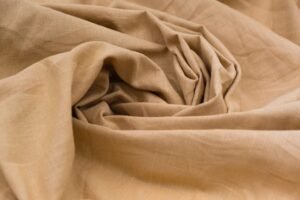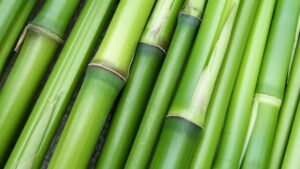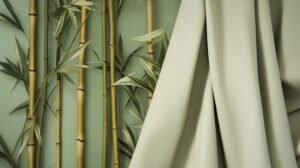Introduction
Viscose from bamboo, often referred to as bamboo rayon, is a type of fabric derived from bamboo plants. This material has gained popularity in recent years due to its sustainability, softness, and versatility. As an eco-friendly alternative to traditional textiles, viscose from bamboo is used in a wide range of products, from clothing to home textiles. However, the production process and its environmental impact are topics of ongoing debate.
Understanding Viscose from Bamboo
What is Viscose?
Viscose is a type of rayon, a semi-synthetic fiber made from natural sources such as wood pulp. The term “viscose” refers to the viscous organic liquid used to make both rayon and cellophane. Viscose fabric is known for its silk-like feel, breathability, and versatility. It is used in various applications, including clothing, upholstery, and industrial products.
What is Viscose from Bamboo?
Bamboo viscose is a form of rayon derived specifically from bamboo fibers. Bamboo is a fast-growing, renewable resource, making it an attractive raw material for textile production. The process of converting bamboo into viscose involves breaking down the bamboo pulp and regenerating the cellulose fibers to create a soft, durable fabric. Bamboo viscose is praised for its eco-friendly origins and desirable properties, such as softness, breathability, and moisture-wicking capabilities.
The Production Process of Bamboo Viscose

Harvesting Bamboo
The process begins with the harvesting of bamboo. Bamboo plants are typically grown without the need for pesticides or fertilizers, and they require less water compared to other crops like cotton. The bamboo used for textile production is usually a type of bamboo known as Moso bamboo, which is not a food source for pandas.
Breaking Down the Bamboo
The harvested bamboo is then chipped into small pieces and soaked in a solution of sodium hydroxide (caustic soda) to break down the bamboo into a pulpy substance. This step dissolves the bamboo into cellulose, which is the primary component used to make viscose fibers.
Regenerating Cellulose
The cellulose pulp is then treated with carbon disulfide, transforming it into a viscose solution. This solution is extruded through spinnerets into a bath of sulfuric acid, which regenerates the cellulose into fibers. These regenerated cellulose fibers are then spun into yarn and woven or knitted into fabric.
Environmental Concerns
While bamboo itself is a sustainable and renewable resource, the process of converting bamboo into viscose raises environmental concerns. The use of chemicals like sodium hydroxide and carbon disulfide can be harmful if not properly managed. Additionally, the production process requires significant water and energy resources. Efforts are being made to develop more environmentally friendly methods, such as the lyocell process, which uses a closed-loop system to minimize chemical waste.
Properties of Bamboo Viscose

Softness and Comfort
One of the most notable properties of bamboo viscose is its softness. The fabric has a smooth, silky texture that is gentle on the skin, making it a popular choice for clothing and bedding. The softness of bamboo viscose is often compared to that of high-quality cotton or silk.
Breathability and Moisture-Wicking
Bamboo viscose is highly breathable, allowing air to circulate and keeping the wearer cool and comfortable. Additionally, the fabric has excellent moisture-wicking properties, meaning it can absorb moisture and quickly evaporate it, keeping the skin dry. This makes bamboo viscose ideal for activewear, underwear, and bedding.
Antibacterial and Hypoallergenic
Bamboo viscose naturally possesses antibacterial and hypoallergenic properties. The fabric resists the growth of bacteria and fungi, reducing the risk of odor and skin irritation. This makes bamboo viscose a great choice for people with sensitive skin or allergies.
Durability and Strength
Bamboo viscose is known for its durability and strength. The fabric can withstand repeated washing and wearing without losing its shape or softness. However, it is essential to follow care instructions to maintain its longevity, such as washing in cold water and avoiding harsh chemicals.
Uses of Bamboo Viscose
Clothing
Bamboo viscose is widely used in the fashion industry for various types of clothing, including:
- T-shirts: Soft, breathable, and comfortable, bamboo viscose T-shirts are popular for everyday wear.
- Underwear: The moisture-wicking and antibacterial properties make bamboo viscose ideal for underwear.
- Activewear: Athletes and fitness enthusiasts appreciate the breathability and moisture management of bamboo viscose activewear.
- Loungewear: Bamboo viscose loungewear offers a luxurious, comfortable feel for relaxing at home.
Bedding and Linens
Bamboo viscose is also commonly used in home textiles, such as:
- Sheets and Pillowcases: The softness and breathability of bamboo viscose make it a popular choice for bed linens.
- Blankets and Throws: Bamboo viscose blankets provide warmth and comfort without being too heavy.
- Towels: Bamboo viscose towels are soft, absorbent, and quick-drying.
Baby Products
Parents often choose bamboo viscose for baby products due to its gentle and hypoallergenic properties. Common bamboo viscose baby products include:
- Clothing: Soft, breathable baby clothes made from bamboo viscose.
- Swaddle Blankets: Gentle, cozy swaddles for newborns.
- Diapers: Eco-friendly, absorbent bamboo viscose cloth diapers.
Environmental and Ethical Considerations

Sustainability of Bamboo
Bamboo is a highly sustainable resource due to its rapid growth rate and minimal need for pesticides and fertilizers. It can be harvested without damaging the plant, allowing it to regrow quickly. Additionally, bamboo helps prevent soil erosion and sequesters carbon dioxide, contributing to environmental conservation.
Environmental Impact of Production
The traditional viscose production process, including bamboo viscose, involves the use of chemicals that can be harmful to the environment if not managed properly. The production process also requires significant water and energy resources. To address these concerns, some manufacturers are adopting more sustainable practices, such as the closed-loop lyocell process, which recycles chemicals and reduces waste.
Ethical Labor Practices
As with any textile production, it is essential to consider the labor practices involved in producing bamboo viscose. Ethical manufacturers ensure fair wages, safe working conditions, and the absence of child labor. Consumers can support ethical production by choosing brands that are transparent about their labor practices and certifications.
How to Care for Bamboo Viscose
Washing
Bamboo viscose garments should be washed in cold water to preserve the fabric’s softness and prevent shrinking. Use a gentle detergent and avoid bleach or fabric softeners, as they can damage the fibers.
Drying
Air drying is the best method for bamboo viscose garments. If using a dryer, choose a low heat setting to prevent damage. Avoid over-drying, as excessive heat can weaken the fibers.
Ironing
If ironing is necessary, use a low heat setting and avoid direct contact with the iron. Place a cloth between the iron and the fabric to prevent scorching.
Storing
Store bamboo viscose garments in a cool, dry place away from direct sunlight. Avoid hanging heavy garments, as this can cause stretching. Instead, fold them neatly to maintain their shape.
Conclusion
Bamboo viscose is a versatile, eco-friendly fabric with numerous desirable properties, including softness, breathability, and moisture-wicking capabilities. While the production process raises some environmental concerns, efforts are being made to develop more sustainable methods. Consumers can make informed choices by supporting ethical brands and adopting proper care practices for bamboo viscose products. As the demand for sustainable textiles continues to grow, bamboo viscose represents a promising option for those seeking environmentally conscious and high-quality fabrics.



